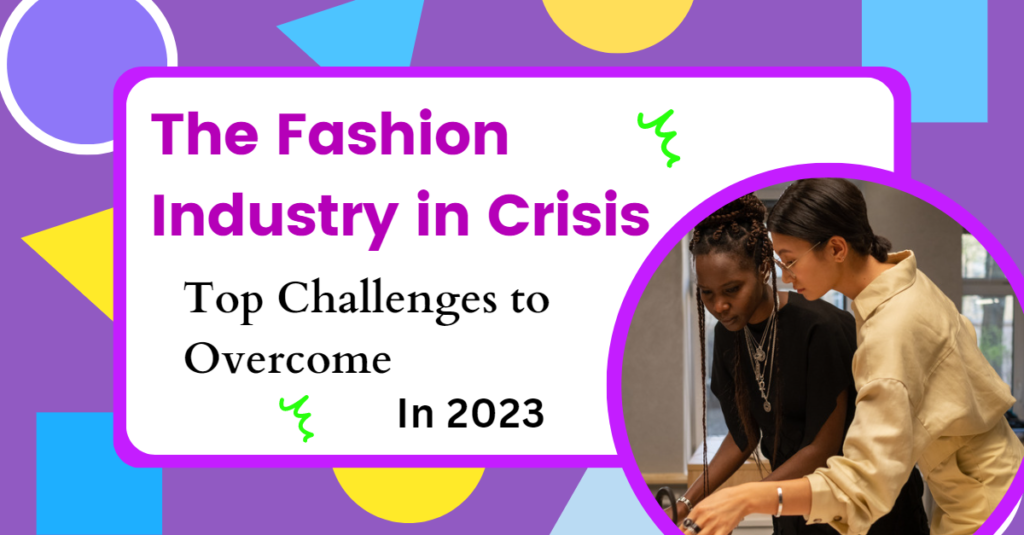The Fashion Industry in Crisis: Top Challenges to Overcome in 2023
The fashion industry has faced a multitude of challenges in recent years, but perhaps none as significant as those that have arisen since the outbreak of the COVID-19 pandemic. The pandemic has brought about a profound change in the way consumers view fashion, and the industry has been forced to adapt rapidly to these new realities. In 2023, the fashion industry is still grappling with the challenges brought about by the pandemic, as well as other longstanding issues that have plagued the industry for years. In this article, we will explore the top challenges facing the fashion industry in 2023 and discuss what steps can be taken to overcome them.
The Fashion Industry in Crisis: Top Challenges to Overcome in 2023
- Sustainability
Sustainability has been a hot topic in the fashion industry for several years now, but it has taken on a new urgency in the wake of the pandemic. With consumers becoming increasingly aware of the impact of their consumption habits on the environment, sustainability has become a key consideration in their purchasing decisions. The fashion industry, however, has been slow to respond to this demand. Many fashion brands still rely on unsustainable practices, such as using synthetic materials and producing garments in countries with lax environmental regulations.
To overcome this challenge, fashion brands must take a more proactive approach to sustainability. This includes using sustainable materials such as organic cotton, recycled polyester, and other eco-friendly fabrics. Brands should also implement sustainable production practices, such as reducing waste and using renewable energy sources. Finally, brands must be transparent about their sustainability practices, providing consumers with information about the environmental impact of their products.
- Digitalization
The pandemic has accelerated the shift towards digitalization in the fashion industry. With physical stores closed for extended periods, consumers have had no choice but to turn to online shopping. This has led to a significant increase in e-commerce sales, as well as a rise in virtual events such as fashion shows and product launches.
While the shift towards digitalization has been necessary to survive the pandemic, it has also highlighted the need for fashion brands to embrace digital technology in the long term. This includes investing in e-commerce platforms, social media marketing, and virtual try-on technology. Brands must also be prepared to adapt to the changing digital landscape, as consumer preferences and behaviors continue to evolve.
- Supply Chain Disruption
The pandemic has caused significant disruption to global supply chains, and the fashion industry has been no exception. With factories closing down and transportation networks disrupted, many fashion brands have struggled to keep up with demand. This has led to supply chain delays, product shortages, and increased costs.
To overcome this challenge, fashion brands must be proactive in managing their supply chains. This includes diversifying their sourcing locations, building more resilient supply chains, and investing in technologies that can help manage inventory and production. Brands must also be prepared to work closely with suppliers and logistics providers to ensure that they can respond quickly to changing circumstances. Read more about The Fashion Industry in Crisis: Top Challenges to Overcome in 2023.
- Changing Consumer Behavior
The pandemic has had a profound impact on consumer behavior, and this is likely to continue in 2023 and beyond. With many consumers still cautious about returning to physical stores, online shopping is likely to remain popular. Additionally, consumers have become more value-conscious, with many looking for affordable, high-quality products.
To overcome this challenge, fashion brands must be prepared to adapt to changing consumer preferences. This includes investing in e-commerce platforms, developing affordable product lines, and providing consumers with more information about the quality and sustainability of their products. Brands must also be prepared to build stronger relationships with consumers, providing personalized experiences and engaging with them through social media and other channels.
- Labor Rights
The fashion industry has long been criticized for its labor practices, with many brands relying on low-cost labor in developing countries. The pandemic has only highlighted these issues, with many workers in the fashion industry facing job losses and unsafe working conditions.
To overcome this challenge, fashion brands must take a more proactive approach to ensuring that their labor practices are ethical and sustainable. This includes working with suppliers to improve working conditions, paying workers fair wages, and providing access to healthcare and other benefits. Brands must also be transparent about their labor practices, providing consumers with information about the conditions under which their products were produced.
Conclusion
The fashion industry faces a multitude of challenges in 2023, from the need to embrace sustainability to the need to adapt to changing consumer preferences and behaviors. While these challenges are significant, they also provide an opportunity for the fashion industry to transform itself for the better. By investing in sustainable practices, embracing digital technology, managing supply chains more effectively, and improving labor practices, fashion brands can build a more resilient and responsible industry that meets the needs of consumers and the planet. The fashion industry must act now to overcome these challenges and build a better future for all.

My name is Rohit Vagh and I’m a content writer specializing in fashion and lifestyle. I have three years of experience in this field and have written various articles. My writing style is creative and engaging, and I strive to create content that resonates with my readers. I have a deep passion for fashion and am constantly researching the latest trends and styles to make sure my readers are up to date. I’m excited to continue my career in blogging, and I’m always looking for new opportunities in the fashion and lifestyle space.





